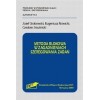- Out-of-Stock



About the book
The book deals with the problem of scheduling tasks. This problem occurs both in production systems and in computer systems and networks. The book presents mathematical models of problems, their properties and algorithms, based primarily on the so-called block method. This method is the original approach in the theory of task scheduling, which, using a simple conceptually and structurally graphical model, properties of the critical path in the graph and some other stuctural properties of problems, allows you to design accurate and approximate algorithms with surprisingly good numerical properties. The presented book is the first in Polish such a comprehensive and comprehensive presentation of the block method that is the output of the authors. After introducing the reader to the problem of scheduling tasks (notation, criteria, computational complexity), three most basic types of scheduling problems are discussed in detail: single-machine problems, flow problems and nesting problems. A number of practical generalizations are also presented, such as: transport, conversion, buffering, limited system capacity, palletizing. A large number of illustrative examples makes reading a book relatively easy, despite its rather theoretical nature.
The book is addressed to students of the senior years of Automation and Robotics as well as Information Technology, PhD students, as well as to research workers. It can also be helpful for planner and designer managers in the field of short-term management and production planning.
No product available!
Thermopad, thermo-adhesive tape, double-sided adhesive 20mm x 130mm x 1mm, 2.4W / mK, AG Thermopiles, RoHS
No product available!
ShutterBox is a device designed to wireless control of electric roller shutters, awnings, screens, etc. by using smartphones and tablets, from any place in the World. It has also powerful time control future, which allows you for example open the blinds on sunrise and close it on sunset
No product available!
ROSA3D filament made of high-quality ASA polymer. 0.7 kg of filament with a diameter of 1.75 mm is wound on the spool. ROSA3D ASA Yellow
No product available!
AVT kit for self-assembly of practical LED clock with alarm clock function. AVT1832 B
No product available!
No product available!
No product available!
No product available!
Module 4-channel opertego switch with relays with the control function via WiFi network. It has three operating modes: as an Access Point, as a local device or as a work mode in the cloud. Shelly 4Pro
No product available!
The VM-03 truck tractor from Ugears is a meticulously crafted plywood model with realistic details such as a coupler, a ladder to the cabin, a sleeping place for the driver with a TV, suspension wheels and a six-cylinder engine that can travel up to five meters with one turn, offering a unique experience for every truck lover. UGears 70056
No product available!
No product available!
The Samsung PM991a 256GB is an M.2 2230 SSD that offers sequential read speeds of up to 3,100 MB/s, write speeds of up to 1,300 MB/s and high IOPS rates, increasing system performance and responsiveness
No product available!
No product available!
3D printer with automatic table leveling and printing resume function. Equipped with a double Z axis and a filament sensor. It offers a large working space of 300 x 300 x 400 mm and uses a fully metal hotend. It allows printing at a speed of 300mm/s, which translates into 30% faster printing compared to previous versions of Sidewinder printers. Artillery Sidewinder X3 Plus
No product available!
Set with orange EL Wire. The set includes an inverter, a 1 to 5 branching and 5 EL Wire in orange color with a length of 1m.
No product available!
No product available!

